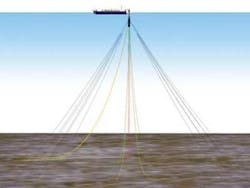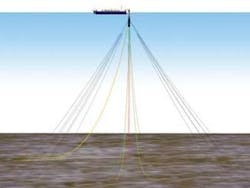SBM Atlantia has released its latest FPSO mooring technology for use in environments where hurricanes, cyclones, or other severe weather threaten operations.
The MoorSpar system is aimed at further enabling the development of deep and ultra deepwater reserves in areas such as the Gulf of Mexico and Southeast Asia, according to SBM Atlantia. It is a disconnectable FPSO mooring system that uses steel catenary risers (SCRs).
SBM Atlantia’s MoorSpar system.
“SCRs are far simpler” than other options such as single-line offset risers, bundled tower, or hybrid configurations, says Philippe Lavagna, SBM Atlantia engineering project manager.
“Typically, up to now deep and ultra deepwater FPSOs had no choice but to use expensive riser towers or hybrid riser systems as the vessel’s heave motions prohibit the use of SCRs,” Lavagna added. “The MoorSpar system de-couples the motion of the vessel from the risers, thereby basically eliminating fatigue issues, while at the same time allowing for disconnection in the event of a storm.”
The MoorSpar unit consists of a truss structure set atop a long, slender buoy and moored to the seafloor by a combination of lateral polyester lines and vertical tethers. The FPSO is connected to the facility through an articulated yoke system linked to a main roller bearing situation below a gimbal table at the top of the MoorSpar unit. This arrangement accommodates the vessel’s roll and pitch motions, while allowing the FPSO to weathervane.
SCRs are, in turn, connected to the MoorSpar unit at riser porches located along the keel of the buoy. The risers are then linked to internal piping which is routed up through the central column and then across hard piping and swivels to the FPSO. The MoorSpar system is also suitable for high pressure and high temperature reservoirs as it avoids the use of flexible jumpers and risers.
The MoorSpar system was successfully model-tested at the MARIN facility in the Netherlands in 2007 to confirm the basis of design and feasibility of connection and disconnection.




